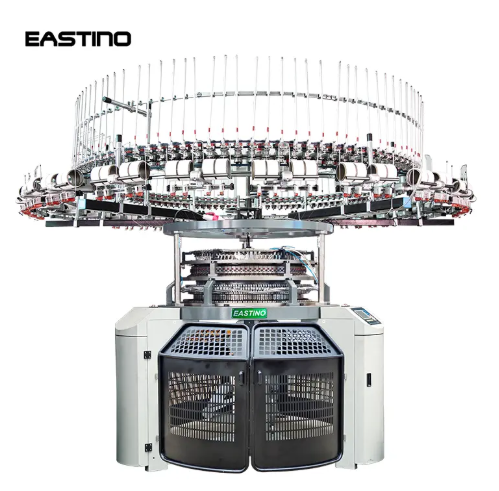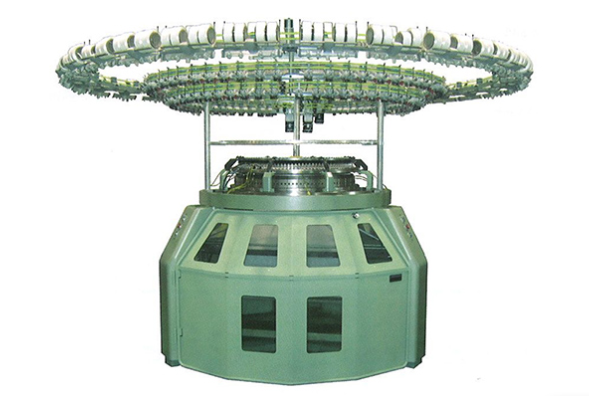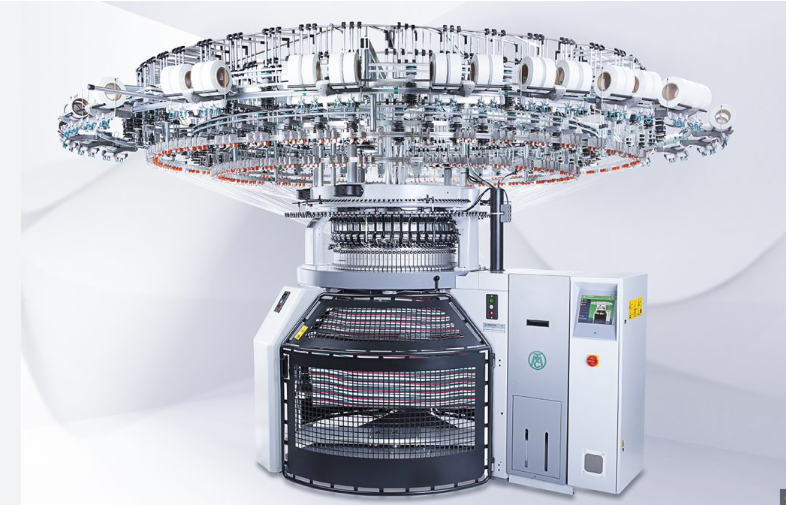Introduction
In recent years, “sandwich scuba” fabrics—also known simply as scuba or sandwich knit—have gained traction in fashion, athleisure, and technical textile markets owing to their thickness, stretch, and smooth appearance. Behind this rising popularity lies a specialized class of circular knitting machines: large-diameter double-knit circular machines capable of producing sandwich constructions.
This article explores how these sandwich scuba large circular knitting machines work, how the market is evolving, and what kinds of fabric samples and end-uses are driving demand today. The goal: offer textile professionals, machinery buyers, and fabric brand strategists a clear and modern view of this niche’s potential.
What Is “Sandwich Scuba” Fabric?
Before diving into machines, it’s worth defining the core product. Scuba knit fabric is a double-knit structure, typically made with polyester and elastane/spandex blends. It is designed to emulate the visual thickness and body of neoprene (used in diving suits) without the rubber core. (Yuanda)
A sandwich knit is a variant of double knit where an extra layer (often a spacer or mesh) is trapped or sandwiched between two outer layers. This “sandwich” gives additional loft, dimensional stability, and breathability. Many modern machines can interconvert cam and needle settings to knit sandwich fabric, scuba, interlock, rib, and more. (rel-tex.com)
Characteristics of sandwich scuba fabrics include:
Good two-way or four-way stretch
Thickness and body (for structured garments)
Visually smooth surfaces on both sides
Moderate compression and resilience (the fabric bounces back)
Potential for lightweight insulation and shape retention
Such fabrics are favored for structured dresses, jackets, body-hugging sportswear, neoprene-alternative activewear, and even décor or technical textile uses.

Machine Principle: How the Large Circular Knitting Machines Work
Double-Knit / Sandwich-Capable Circular Machines
The machines used for sandwich scuba are usually double-jersey / interlock / double-knit circular machines with advanced cam systems. They have multiple cam tracks to allow different knitting motions — for example, knitting two outer layers and optionally connecting or sandwiching in between. (rel-tex.com)
Key features include:
Multiple cam tracks: The cylinder and dial cams are arranged so the machine can produce outer layers and middle layers (or connect them) by altering cam and needle configurations. (rel-tex.com)
Needle selector systems or jacquard attachments: Allow selective needle activation for patterning or varying density.
Adjustable spacing: The distance between needle beds or supporting sinkers can be fine-tuned to accommodate the “sandwich gap.”
High gauge / fine gauge needles: To achieve fine loops and tight structure, fine gauges (e.g. 28G, 32G, 36G) are commonly used. (Facebook)
Computerized controls: Modern machines integrate servo motors, computerized tension control, and monitoring to keep loop consistency and quality high.
Yarn feeding / layering: A multi-yarn feed system allows polyester, spandex, or special yarns (monofilament, mesh) to be introduced in precise feeding zones to create the internal sandwich or spacer layer. (Yuanda)
In operation, the machine rotates in a cylinder fashion. Outer layers are knitted by one set of needles and the inner layer by another. Depending on cam settings, the layers may be joined (interlock), remain separate (layered), or act as a sandwich cushion.
Compared to single-jersey machines, these double-knit machines are more complex, require more precision, and often operate at slightly lower rpm to maintain quality in dense fabric construction.
Workflow Steps in Production
1.Yarn supply and setup
Tow or bobbin yarns of polyester, spandex, or blends are loaded. Some sandwich designs may use monofilament or spacer yarns between layers.
2.Cam / needle configuration
Engineers program cam tracks and needle selector logic to define which needles knit outer layers, which knit inner, and how/where connection loops occur.
3.Knitting stage
The machine cycles, creating continuous tubular sandwich fabric. The structure builds up as loops in the respective layers interlink or remain separated.
4.Quality monitoring
Tension sensors, yarn break detectors, and vision inspection are often active to catch defects early.
5.Take-down, finishing, and rolling
After knitting, the tube is usually opened, scanned, heat-set, and rolled or further processed (e.g. brushing, lamination, dyeing).
Because of sandwich structure, the fabric is more dimensionally stable, with better “body” and recovery compared to lighter knits.
Market Landscape & Growth Forecast
Machinery Market Trends
The global knitting machine market is expanding strongly, and circular / large circular knitting machines are a key segment. Precedence Research forecasts the overall knitting machine market will grow from USD 5.56 billion in 2025 to around USD 10.54 billion by 2034, a CAGR of ~7.37 %. (Precedence Research)
Specifically, the large circular knitting machine segment is forecasted to grow, with market size expected to surpass USD 1,923 million by 2030 from about USD 1,247 million in 2022, owing to demand in technical textiles, sportswear, and innovation. (consegicbusinessintelligence.com)
Another report by Technavio estimates a 5.5% CAGR for the large circular knitting machine market during 2023–2028. (Technavio)
Drivers fueling the segment include:
The demand for high-performance fabrics (sports, athleisure, shapewear)
The push for fewer seam garments and seamless textile production
Growth in technical textile applications (automotive linings, protective wear, décor)
Automation and smart control making complex structures like sandwich knits more feasible
Fabric / End-Use Market & Demand
Sandwich scuba knits occupy a niche but growing space. Key application areas:
Fashion & Apparel: Structured dresses, skirts, fit-and-flare designs, jackets that benefit from memory, shape, and thickness
Athleisure / Activewear: Thick but stretchy support leggings, medium-stability workout tops
Technical Textiles: Cushioning, padded liners, seating, or protective textile layers
Home Decor / Upholstery: Decorative panels, pillow covers, structured cushions
Costume / Cosplay: Thick, camera-friendly fabrics with body and drape

Sample Fabric Types & Applications
Here are several example constructions or “fabric samples” that sandwich scuba machines can produce:
|
Fabric Sample Type |
Description / Construction |
Possible Uses |
| Classic Scuba Double-Knit | Two outer layers, minimal connecting loops | Dresses, skirts, jackets |
| Sandwich with Mesh Core | Mesh spacer sandwiched between layers | Lighter weight but still structured apparel |
| Gradated Density Sandwich | Varying density in zones (e.g. compressed waist, looser leg) | Compression garments with fashion profile |
| Patterned Sandwich / Jacquard Scuba | Embedded motifs or relief in outer layers | Decorative panels, statement garments |
| Bonded / Laminated Sandwich | Outer scuba knit + functional membrane or film | Waterproof structured outerwear |

Competitive & Regional Dynamics
Regional Strengths
Asia-Pacific: Leading in textile machinery manufacturing and fabric production. Many sandwich scuba machines originate from China.
Europe: Focused on high-precision, high-end models for niche technical markets.
North America: Growing demand for domestically produced technical fabrics (reshoring trends).
Competitive Landscape
Key players in large circular knitting machinery, including sandwich-capable units, include:
Mayer & Cie.
Santoni
Fukuhara
EASTINO
Challenges & Technical Risks
Capital investment: These machines typically cost more than simpler single-jersey machines.
Operational complexity: Cam setup, needle selection, and balancing tension are more demanding.
Quality consistency: Maintaining loop uniformity and avoiding defects such as layer separation or mislinks is critical.
Material compatibility: The interaction among polyester, spandex, spacer yarns, and finishes must be well-matched.
Energy / speed trade-offs: Running too fast can compromise fabric integrity; speeds are often lower than basic knits.

Future Outlook & Innovation
Several emerging trends could amplify sandwich scuba knitting machine adoption:
Smart / adaptive knits: Embedding conductive yarns or sensors into the sandwich layer for wearables.
Sustainable fibers: Using recycled PET or bio-based yarns in sandwich knits to reduce carbon footprint.
3D knitting / full-garment knit: Evolving machinery to knit shaped 3D pieces with sandwich layers, reducing waste.
AI-driven quality control: Real-time defect detection and self-adjustment in knitting parameters.
As demand for performance-fashion hybrids continues, sandwich scuba knits may gain share over heavier woven fabrics or laminates.
Post time: Oct-25-2025
